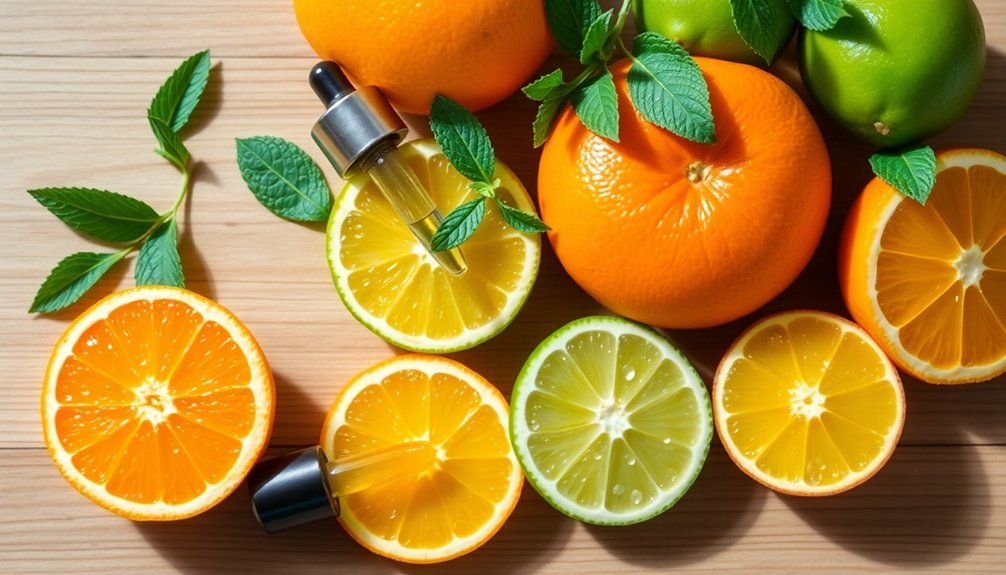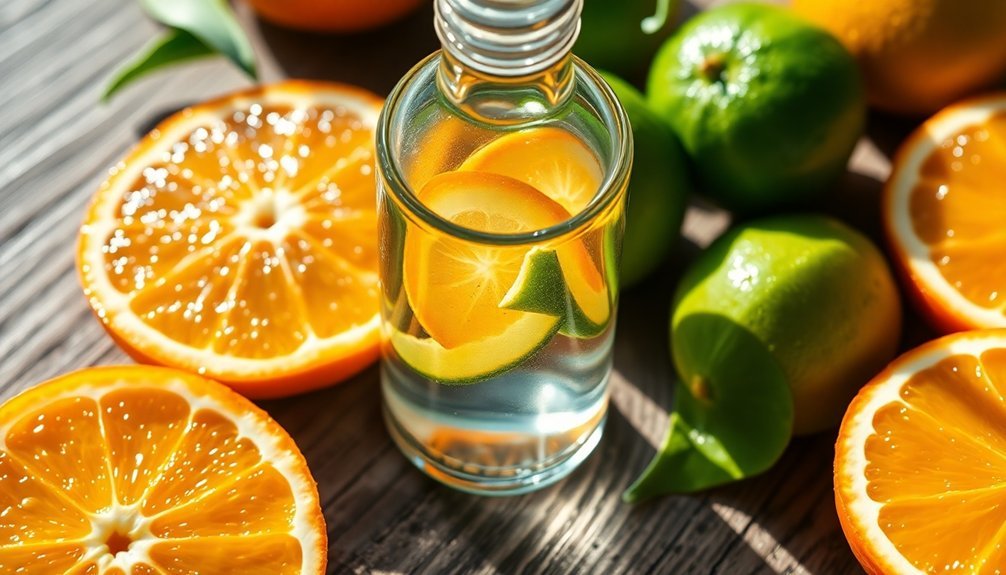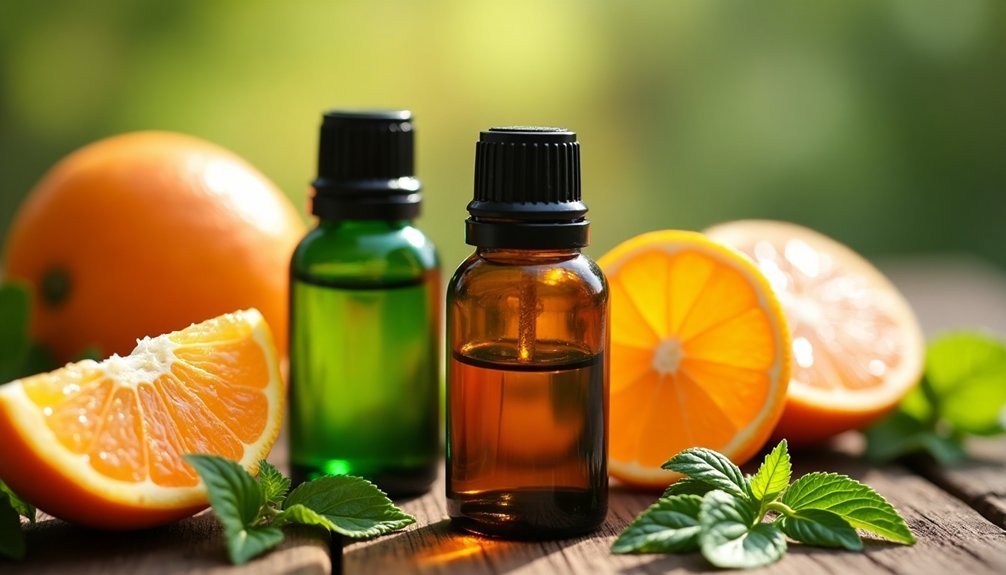For a fresh tangerine and lime essential oil perfume, dilute your oils in a 1:4 ratio with a carrier oil, aiming for a 5% dilution (about 45 drops per ounce). Store your blend in amber or cobalt glass bottles at 60-70°F to preserve freshness. Apply to pulse points on clean, moisturized skin, and avoid rubbing the spots together. You'll want to customize your blend seasonally, adjusting top and base notes for ideal results. There's much more to discover about creating your perfect citrus signature scent.
Essential Safety Measures for Citrus Oil Blending

When working with citrus essential oils, proper safety measures are essential to prevent skin irritation and adverse reactions.
Never apply pure citrus oils directly to your skin – instead, dilute them in a carrier oil using the 1:4 ratio. Essential oils can seriously damage materials, so avoid any spillages during your blending process. Before creating your perfume blend, perform a patch test on a small area of non-sensitive skin to check for any adverse reactions.
Keep your blending workspace free from potential hazards, and store your oils in amber or cobalt-blue glass bottles to protect them from light degradation.
If you're pregnant, nursing, or have underlying health conditions, consult your physician before using citrus oils.
When testing your perfume blend, use perfume tester strips rather than applying it directly to your skin. If you experience any redness, rash, or burning sensation, discontinue use immediately.
Understanding Proper Dilution Ratios
Since essential oils are highly concentrated plant extracts, proper dilution is crucial for safe and effective use in perfume making.
For your citrus-based perfume, you'll want to aim for a 5% dilution ratio, which is appropriate for fragrance applications. This means you'll need to carefully measure your essential oils and carrier oil to achieve the right balance. Using an essential oil dilution calculator can help ensure precise measurements for your blend.
When working with tangerine and lime oils, remember they're phototoxic, so you shouldn't exceed recommended ratios.
For a 1-ounce (30ml) perfume blend, you'll need approximately 45 drops of your combined essential oils mixed with carrier oil. Always use proper measurement tools to guarantee accuracy.
Before applying your perfume, don't forget to perform a patch test on a small area of skin to check for any sensitivities, especially since citrus oils can be more reactive.
Selecting Premium Tangerine and Lime Oils

Choosing premium-quality essential oils serves as the foundation for creating an exceptional citrus perfume. When selecting tangerine oil, look for cold-pressed oil derived from Citrus reticulata peels, which should have a greenish-orange color and thin consistency. The oil's major constituents, including limonene and γ-terpinene, contribute to its antioxidant properties. The sweet citrusy aroma provides an uplifting and refreshing scent profile that perfectly balances the blend.
For lime oil, you'll want cold-pressed oil from either Citrus aurantifolia or Citrus latifolia, displaying a pale yellow or greenish hue. While both oils complement each other beautifully in blends, remember that lime oil is phototoxic, unlike tangerine.
Store both oils properly to prevent oxidation, and always dilute before skin application. For the best results, consult an aromatherapy practitioner, especially if you have specific health conditions.
Perfume Blending Techniques and Proportions
Creating professional perfumes requires a solid understanding of fragrance concentrations and note ratios. For your tangerine and lime blend, you'll want to follow the 30-50-20 rule: 30% top notes (citrus oils), 50% middle notes, and 20% base notes.
If you're making an Eau de Toilette (EDT), use 10% fragrance oils and 90% alcohol.
To achieve the best results, you'll need to add your oils gradually to the alcohol base, mixing thoroughly after each addition. Test your blends on fragrance strips before finalizing the proportions.
Don't forget to let your perfume mature for several weeks to develop its full character. Store your creation in dark bottles, and always measure precisely using graduated cylinders to maintain consistency in your formulations.
Creating Your Signature Citrus Scent Profile

When developing your signature citrus scent profile, you'll want to understand how different citrus oils interact and complement each other. Start with vibrant top notes like lemon or lime for that initial burst of freshness, then layer in tangerine or grapefruit to add complexity.
Bergamot's earthier, spicier qualities can help bridge your citrus notes with deeper base notes.
To create a lasting impression, combine your citrus oils with complementary middle notes like florals or herbaceous elements. Verbena's subtle herbal character can soften the blend while extending its longevity.
Consider the seasonal context of your fragrance – citrus notes shine particularly bright in spring and summer compositions. For added depth, experiment with contrasting elements, pairing sweet tangerine with tart grapefruit or blending zesty lime with grounding bergamot.
Storage and Shelf Life Guidelines
Proper storage of your essential oil perfumes can greatly extend their lifespan and maintain their therapeutic properties.
Keep your blends in a cool, dark place between 60-70°F, away from direct sunlight and heat sources. Your bathroom isn't an ideal storage spot due to humidity fluctuations.
Store your perfumes in amber or cobalt glass bottles with airtight caps to protect against UV rays and oxidation. If you're using a large bottle, consider transferring some to smaller containers to minimize air exposure.
Always keep bottles upright and quickly recap them after use. When handling your perfumes, don't let the dropper tip touch your skin to prevent contamination.
Maintain a consistent environment with moderate humidity (50-60%) and store your collection in a drawer or closed box away from artificial light.
Natural Benefits of Citrus Oil Perfumes

When you choose citrus oil perfumes, you'll benefit from their natural mood-lifting properties that can boost your energy and reduce stress throughout the day.
These bright, uplifting scents work as natural deodorizers, effectively neutralizing unwanted odors rather than masking them.
Mood-Enhancing Citrus Properties
Through their remarkable interaction with the brain's limbic system, citrus essential oils offer powerful mood-enhancing benefits that can transform your daily aromatherapy experience.
When you incorporate tangerine and lime oils into your perfume blend, you'll harness both calming and invigorating properties. Tangerine's sedative effects help reduce anxiety, while lime's bracing aroma instantly energizes your spirit.
You'll notice these citrus oils naturally boost your serotonin levels, promoting happiness and mental clarity.
If you're seeking stress relief, bergamot oil is particularly effective at cultivating positive feelings.
For the best results, you can apply your citrus perfume blend to pulse points using a carrier oil, but remember to protect your skin from sun exposure afterward.
Always choose high-quality oils from trusted sources to guarantee maximum mood-enhancing benefits.
Natural Odor-Fighting Power
Natural citrus oils offer remarkable odor-fighting abilities beyond their pleasant fragrance, thanks to their powerful antimicrobial properties. When you incorporate tangerine and lime oils into your perfume, you're not just masking unwanted scents – you're actively eliminating them through natural compounds like d-limonene and citral.
These essential oils combat odor-causing bacteria in three key ways:
- Their antimicrobial properties destroy harmful microbes that cause body odor
- Their chemical structure breaks down airborne contaminants rather than covering them up
- Their antifungal components prevent the regrowth of odor-causing organisms
You'll get the best results by combining citrus oils with complementary essential oils like tea tree or eucalyptus.
For long-lasting freshness, store your natural perfume in the refrigerator and reapply as needed throughout the day.
Eco-Friendly Fragrance Choices
Choosing citrus-based essential oil perfumes delivers both environmental and wellness benefits that synthetic fragrances can't match.
When you select perfumes made with lemon, orange, or bergamot oils from responsibly managed farms, you're supporting sustainable agriculture and local communities while protecting biodiversity.
These natural fragrances offer powerful antioxidant and antibacterial properties through their rich content of flavonoids and limonoids.
You'll avoid harmful chemicals like phthalates and synthetic musks found in conventional perfumes, making them ideal if you have sensitive skin.
Plus, you can trust products that clearly list their natural ingredients and origins.
For the best results, look for brands that prioritize organic farming methods and maintain transparent sourcing practices.
You'll enjoy mood-boosting aromatherapy benefits while making an eco-conscious choice for your personal care routine.
Seasonal Wearing and Application Tips

When crafting your essential oil perfume collection, adapting your blends and application methods to the seasons can dramatically enhance your fragrance experience.
For spring and summer, opt for lighter citrus-forward blends with increased top notes, while autumn and winter call for warmer, spicier compositions with more base notes.
To maximize your perfume's effectiveness throughout the year, remember these essential application tips:
- Apply to clean, moisturized skin at pulse points like wrists, neck, and behind ears – but don't rub the spots together
- Adjust your blend ratios seasonally: use 2:4:6 (top:middle:base) as your starting point per 10ml carrier oil
- Test new blends on a small skin area and allow 24 hours for the scent to mature before making final adjustments
Remember to always dilute your oils properly and choose application spots based on the season's temperature.
Frequently Asked Questions
Can I Layer Tangerine and Lime Perfume With Other Commercial Fragrances?
You can layer tangerine and lime with commercial fragrances, but test combinations first on your skin. Choose scents with complementary base notes like vanilla, sandalwood, or musk for the best results.
How Long Does the Citrus Scent Typically Last on Skin?
You'll notice citrus scents fade quite quickly, typically lasting 15-30 minutes in their pure form. Even in commercial perfumes, they'll usually dissipate within 2-4 hours unless they're anchored with longer-lasting notes.
Will Citrus Perfume Attract Insects During Outdoor Activities?
No, citrus perfumes won't attract insects – they'll actually help repel them. Your citrus scents interfere with insects' respiratory systems, making you less attractive to mosquitoes, bees, and wasps during outdoor activities.
Can Tangerine and Lime Essential Oils Stain Clothing?
Yes, tangerine and lime essential oils can stain your clothes. While they're lighter in color than other oils, they'll still leave marks if not properly diluted. It's best to avoid direct contact with fabric.
Does Temperature Affect the Scent Intensity of Citrus Perfumes?
Yes, temperature considerably affects your citrus perfume's intensity. You'll notice it's stronger in hot weather as heat increases evaporation, making scents more powerful but shorter-lasting. Cold temperatures make citrus notes subtler.
In Summary
You've now learned how to safely create and enjoy your own citrus essential oil perfume. Remember to store your blend in a dark glass bottle, away from direct sunlight and heat. While your tangerine and lime perfume will bring a burst of energizing freshness to your daily routine, don't forget to perform a patch test and follow proper dilution guidelines for the safest, most enjoyable experience.
References
- https://www.newdirectionsaromatics.com/products/tangerine-fragrance-oil
- https://vetiveraromatics.com/blogs/news/4-safety-tips-for-making-perfume-with-essential-oils
- https://www.coursehero.com/file/143090139/Research-Proposalpdf/
- https://rusticstrength.com/products/tangerine-lime-essential-oil-blend
- https://www.healthline.com/health/are-essential-oils-safe
- https://www.newdirectionsaromatics.com/blog/the-theory-practice-of-essential-oil-blending/
- https://www.clarityblend.com/blogs/our-journal/3-simple-rules-for-safe-use-of-essential-oils
- http://mit.edu/~ecprice/Public/freq/googlelist.counts
- https://www.newdirectionsaromatics.com/blog/blending-and-diluting-essential-oils/
- https://miraclebotanicals.com/a/blog/7-tips-for-using-essential-oils-safely





Leave a Reply